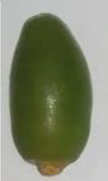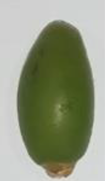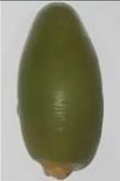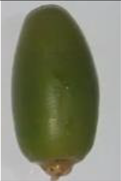Abstract
This study evaluated the influence of different male date palm cultivars, distinguished by their chloroplast haplotypes, on pollen quality, pollination efficiency, metaxenia effects, and gene expression during fruit development. Chloroplast DNA analysis of 37 male trees revealed multiple haplotypes, from which cultivars B25, P8, C22, and B46 were selected for further investigation. Pollen viability varied significantly among cultivars, with P8 and B25 exhibiting the highest germination rates and pollen tube elongation, while C22 showed the lowest. These differences correlated with pollination success: P8 and B25 achieved fertilization rates near 99%, whereas C22 remained below 43%. Pollination outcomes also varied in fruit traits. Despite its low pollen performance, C22 induced the production of larger fruits at the Bleh (Kimri) stage, potentially due to compensatory physiological mechanisms. Phytochemical profiling revealed significant cultivar effects: fruits from B25-pollinated trees had with lower moisture and polyphenol content but the higher sugar levels and soluble solids, suggesting accelerated maturation. Ripening patterns confirmed this finding, with B25 promoting the earliest ripening and B46 causing the most delayed. Gene expression analysis supported these phenotypic differences. Fruits pollinated by P8, B25, and B46 exhibited elevated levels of cell-division-related transcripts, particularly the PdCD_1 gene (PDK_XM_008786146.4, a gene encoding a cell division control protein), which was most abundant in P8. In contrast, fruits from C22-pollinated trees had the lowest expression of growth-related genes, suggesting a shift toward cell expansion rather than division. Overall, the results show the critical role of male genotype in influencing fertilization outcomes and fruit development, offering valuable insights for targeted breeding strategies at enhancing date palm productivity and fruit quality.
1. Introduction
The date palm (Phoenix dactylifera L.) is a dioecious species of great economic and cultural significance in arid and semi-arid regions. Selecting appropriate male date palm trees is pivotal for improving fruit set, quality, and yield, as the pollen not only contributes to successful fertilization but also influences fruit traits via the phenomenon of metaxenia [1]. Metaxenia refers to the influence of pollen (specifically the male parent) on the characteristics of the fruit tissue derived from the female parent. Historically, male date palm selection has been primarily based on observable morphological traits such as pollen quantity, viability, and flowering time [2]. Recent advances with molecular tools have made genotyping approaches essential for detecting genetic variations among male genotypes, facilitating more efficient selection criteria [3]. In fact, the morphological assessment of male date palms includes the analysis of inflorescence traits, pollen grain size, and viability, all of which directly impact fruit set efficiency [4]. Pollen viability combined with germination rates are the main traits influencing the pollination success, and they significantly change among male genotypes [5]. Metaxenia is particularly significant due to its direct impact on fruit quality and commercial value and should be considered in date palm breeding programs [6].
Recent advances in molecular biology have facilitated the genetic differentiation of date palm cultivars. Chloroplast DNA (cpDNA) analysis has emerged as a powerful tool in identifying chlorotypes, which can be used to classify male genotypes and understand their genetic diversity [7]. The identification of chloroplast haplotypes could provide insights into the paternal lineage, enabling breeders to optimize male selection strategies to enhance fruit yield and quality [8]. Recent findings from our research provide detailed insights into the genetic diversity of Tunisian date palm cultivars by sequencing the mitochondrial and chloroplast genomes of 171 accessions. This study identified distinct haplotypes that enhance our understanding of the evolutionary relationships among date palm genotypes and hold significant implications for breeding and conservation strategies [9].
The sources of pollen can significantly affect fruit size, weight, sugar content, and ripening time [10,11]. Several studies have further demonstrated that variations in pollen genotype can influence the biochemical composition and postharvest characteristics of the fruit [12], highlighting the importance of genetic evaluation in male breeding lines. While nuclear genetic markers are essential for understanding trait inheritance, organellar markers can provide complementary information for distinguishing male lineages. In this context, our previous work [9] contributed to characterizing chloroplastic and mitochondrial diversity among Tunisian date palms, laying a foundation for identifying distinct male genotypes and guiding future breeding programs.
Additionally, environmental conditions and pollen storage methods are crucial factors influencing pollen viability and germination success. Factors such as temperature, humidity, and storage duration can significantly impact pollen performance, thereby affecting pollination efficiency and fruit quality [13]. This underscores the significance of integrating both morphological and molecular data to identify the most suitable male date palm genotypes for breeding programs.
The present study aims to assess the impact of different male date palm genotypes, each characterized by distinct chlorotypes, on pollen germination and the subsequent effects on fruit characteristics. Specifically, it investigates the morphological and molecular diversity among selected male genotypes, their pollen germination capacity, and the influence of different pollen sources on fruit quality traits, including size, sugar content, ripening time, and gene expression. By integrating morphological, molecular, and physiological analyses, this study seeks to establish a comprehensive framework for optimizing male selection in date palm breeding programs, thereby contributing to enhanced fruit yield and quality.
2. Results and Discussion
2.1. Chlorotypes Analysis of the Selected Male Cultivars
As reported in our previous study [9], date palm accessions were classified into two primary groups based on their chloroplast haplotypes (Figure 1). Group 1 includes the reference sequence (GU811709.2, cv. Khalas), which is identical to haplotype H2. Within this group, the cultivar P8 exhibits the H9 chlorotype, which is closely related to H3 and corresponds to male C22 and the widely cultivated female Deglet Nour variety. It is notable that the majority of male date palms in Tunisian oases possess the H3 haplotype, which supports the hypothesis that these male individuals originated from the widely cultivated female Deglet Nour variety.
Conversely, Group 2 encompasses a wider range of haplotypes and comprises most of the female date palm varieties that are endemic to Tunisia. It is presumed that these local cultivars evolved in response to specific environmental pressures and may harbour genetic adaptations that favour resilience in arid and semi-arid conditions [14]. Understanding the genetic composition of these varieties could provide valuable insights into their physiological and adaptive traits, particularly with regard to drought resistance and soil salinity tolerance [15]. Additionally, male accession B46 was found to possess the H1 chlorotype, indicating a distinct genetic lineage. Meanwhile, the newly sequenced cpDNA of accession B25 revealed a novel haplotype within Group 2, highlighting B25 as a unique genetic entity that may represent an uncharacterized lineage with distinct genetic and physiological attributes.
2.2. In Vitro Analysis of Pollen Germination and Tube Elongation
The pollen germination percentages and pollen tube lengths of various male date palm cultivars differed significantly between the two flowering waves (Figure 2), indicating the influence of both genetics and the environment on pollen performance. Male P8 exhibited high pollen germination rates, with a percentage rising from 71.54% in the first hour to 95.07% after six hours in wave 1 and from 74.79% to 90.71% in wave 2. It also developed the longest pollen tubes, increasing from 281 µm in wave 1 to 390 µm in wave 2, indicating high pollen viability and strong tube elongation potential. Similarly, B25 demonstrated substantial pollen tube growth, increasing from 214 µm to 374 µm, and showed a change in germinative power from 66.63% to 84.55% in wave 1 and from 68.89% to 82.02% in wave 2, reinforcing its efficiency in fertilization. B46 exhibited rising germination rates, from 66.63% to 92.45% in wave 1 and from 43.54% to 81.23% in wave 2, alongside moderate tube elongation, from 204 µm to 270 µm. This indicates average performance. By contrast, C22 exhibited the lowest germination percentages in wave 1, rising from 20.90% to 59.34%. However, its performance improved in wave 2, initially reaching 65.47% and rising to 82.23%. Despite this improvement, C22 consistently produced the shortest pollen tubes rising from 138 µm to 204 µm, which potentially limited its fertilization efficiency. Overall, wave 2 consistently showed greater initial pollen germination and longer pollen tubes across all cultivars, likely due to improved environmental conditions and pollen maturity.
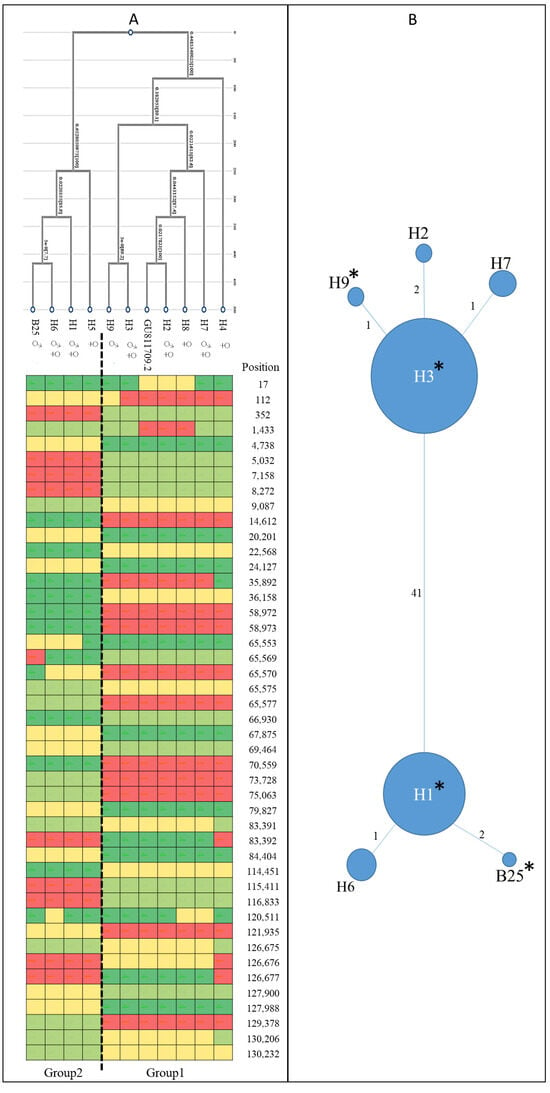
Figure 1.
Phylogenetic tree (A) of the various chlorotypes displaying SNP positions, constructed using FastTree v2.1.8 with default settings [16] and male haplotypes network (B). Haplotypes H1 to H9 were determined by Hamza et al. [9]. GU811709.2: reference sequence [17]. Symbols ♂ and ♀ indicate the sex of trees possessing a single haplotype. Numbers indicate the SNP number between haplotypes. The haplotypes corresponding to the male cultivars in this study are shown with stars.
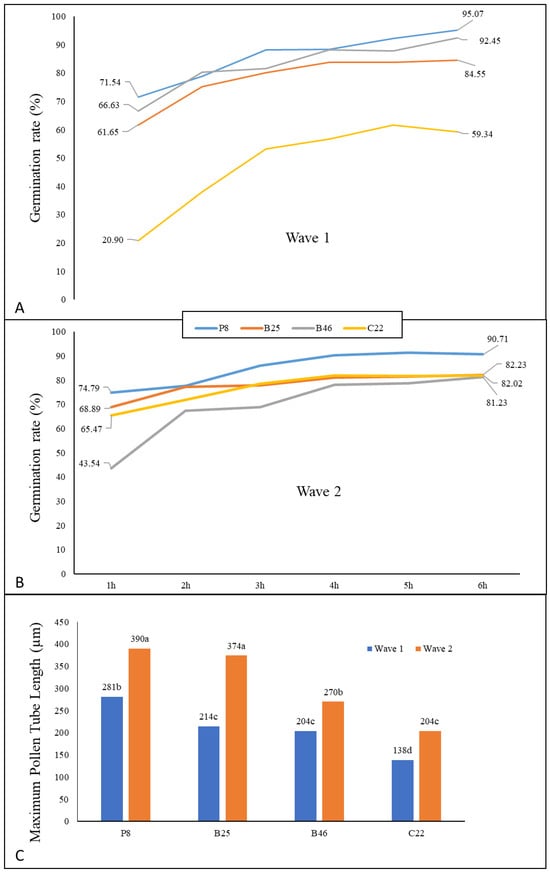
Figure 2.
Temporal evolution of pollen germination rates (A,B) and maximum pollen tube lengths (C) in various male date palm cultivars from two flowering waves (i.e., sequential flowering phases occurring within the same season).
The variation in pollen tube length among the different cultivars further emphasizes the importance of genetic factors in pollen performance. P8 and B25 exhibited the longest pollen tubes, indicating greater efficiency in tube elongation and potentially enhancing fertilization success [18]. While both pollen germination percentage and tube length contribute to fertilization success, no direct correlation was observed between the two. For example, B46 and C22 had relatively low germination percentages and shorter pollen tubes, indicating that other physiological and genetic mechanisms influence tube elongation. Similar findings have been reported in pollen studies of other plant species, where cytoskeletal dynamics, vesicle transport, and Ca2+ signalling regulate pollen tube growth independently of germination rates [19,20].
2.3. Pollination Efficiency
Female date palm cultivars that are pollinated by the male cultivars P8 and B25 have significantly higher pollination rates than those pollinated by other cultivars (Figure 3). These rates reach 98.92% and 98.93%, respectively. The proportion of unpollinated dates is very low at 1.08% and 1.07% for P8 and B25, respectively. The female palms pollinated by B46 followed these results, showing a pollination rate of 95.76% and 4.06% of unpollinated dates. Conversely, the female palms pollinated by cultivar C22 demonstrated a significantly lower pollination rate: only 42.37% of dates were pollinated compared to 55.71% that were unpollinated, highlighting a striking difference relative to the other male cultivars. These results suggest that pollination effectiveness is strongly dependent on the pollen source, corroborating previous studies emphasizing the critical role of pollen quality in successful fertilization [6].
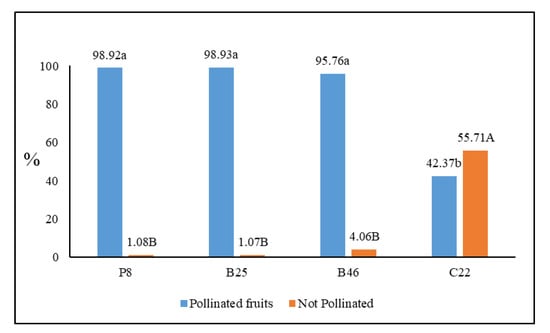
Figure 3.
Proportions of pollinated and non-pollinated Deglet Nour fruits following pollination with pollen from the studied male cultivars. Means sharing the same letter are not significantly different at p < 0.05.
Several key factors can influence variations in pollination rates, including pollen viability, germination percentage, and pollen tube growth. It is well established that pollen viability varies among male cultivars and directly affects the success of fertilization [1]. Pollen with higher viability tends to exhibit increased germination rates, resulting in more efficient fertilization and higher fruit set [21]. Furthermore, pollen tube length is a critical determinant of fertilization, as it influences the pollen grains’ ability to reach the ovule [22]. Our findings further support this, demonstrating that C22 had the shortest pollen tube, thereby reducing its pollination efficiency.
2.4. Morphological and Phytochemical Characterization
Significant variations in fruit length, width, and weight were observed among date palm cultivars at the Bleh stage (Table 1). Despite lower pollination success, cultivar C22 exhibited an increase in fruit size, which suggests the existence of a possible physiological compensation mechanism in response to reduced fertilization [23]. In terms of fruit flesh thickness, cultivar C22 had the thickest mesocarp, while B25 had the thinnest. Compared to B25, cultivars, P8 and B46 exhibited superior fruit dimensions, with an increase in fruit weight of at least 1.02 g per fruit, corresponding to an approximate yield gain of 12.51% per tree. These findings emphasize the influence of pollination success and the genetic traits of the pollinating male cultivars on fruit characteristics such as length, width, and weight. Cultivars P8 and B46, which produced larger and heavier fruit, likely benefited from enhanced pollination efficiency, potentially due to superior pollen viability and germination.

Table 1.
Morphological parameters of the dates obtained after pollination by the studied male cultivars.
Variations in mesocarp structure among cultivars highlight the genetic and physiological diversity that directly influences fruit quality and productivity. These observations emphasize the importance of targeted pollination management to optimize yield and fruit quality in date palm plantations. Studies have shown that different pollinator genotypes can influence fruit length and diameter via the metaxenia effect, whereby pollen-derived signals affect fruit development [11]. The productivity of date palms, in terms of fruit quantity and quality, is closely linked to the quality of pollen grains, which varies among male genotypes [24]. This underlines the importance of selecting pollen sources with high viability to improve fruit set and improve economic returns in commercial date palm cultivation.
Data indicates that dates resulting from pollination by the P8, C22, and B46 cultivars exhibit higher water content, at 82.18%, 81.78%, and 81.71%, respectively (Table 2). This suggests that these male cultivars contribute to fruit characteristics associated with enhanced water retention, possibly due to differences in cellular structure or osmotic balance. Conversely, dates pollinated by the B25 cultivar had the lowest water content (80.68%), potentially impacting their texture and physiological development.

Table 2.
Water content, sugar accumulation, and polyphenol variability in date palm fruits at the Bleh (Kimri) stage.
According to Barreveld [25], during the Kimri (Bleh) stage, there is a rapid increase in fruit size, weight, and sugar content. This period is also characterized by the highest acidity and peak moisture content, which can reach up to 85%. These parameters tend to stabilize toward the end of this stage as the fruit transitions to a yellow or red color, depending on the cultivar. The observed decrease in water content in B25 pollinated fruits at the Bleh stage may indicate the onset of ripening, potentially accelerating the progression to the next developmental phase. Since water content is closely linked to sugar concentration, it fluctuates significantly throughout ripening, declining gradually from the late Bleh stage to mid-Besser, when fruit softening begins, and then decreasing more rapidly during the Tamer stage [26].
Total soluble solids (°Brix) were highest in fruits pollinated by B25 (2.15%), indicating a higher concentration of soluble sugars. This was followed by P8 (2.00%), C22 (1.98%), and B46 (1.75%). At the Bleh stage, dates are immature and green with a firm, crunchy texture and relatively low sugar content. Fruits pollinated by B25 also exhibited the highest total sugar content (6.98%), followed by B46, C22, and P8, with values of 5.91%, 5.78%, and 5.41%, respectively. The elevated sugar concentration and reduced water content in fruits pollinated by B25 likely contribute to a firmer and denser mesocarp at maturity compared to fruits pollinated by other cultivars. Previous studies have shown that sugar accumulation and moisture levels significantly affect fruit texture, influencing consumer preferences and storage properties [27,28].
Rygg [29] described two distinct phases within the Bleh stage. The first phase is marked by a rapid increase in weight and volume, accumulation of reducing sugars, progressive rise in total sugars and soluble solids, high acidity, and elevated moisture content. The second phase involves a slower increase in weight and volume, a decline in the rate of reducing sugar accumulation, a deceleration of total sugar synthesis, and a slight decrease in acidity. This metabolic transition is crucial for determining fruit quality and the dynamics of the ripening process.
The polyphenol concentration varied depending on the pollen source used for pollination. Fruit pollinated by B25 had the lowest polyphenol content (0.81 mg GAE/100 g), while fruit pollinated by B46 had the highest levels (1.31 mg GAE/100 g). Intermediate values were observed in fruits pollinated by P8 and C22, at 1.14 mg GAE/100 g and 1.02 mg GAE/100 g, respectively. Polyphenol content is typically elevated at the Bleh stage but decreases progressively as the fruit matures toward the Tamer stage. This decline is accompanied by a reduction in tannins, which give immature dates their astringent taste [30]. Al-Turki et al. [31] reported that levels of phenolic compounds levels in dates vary depending on both the cultivar and the developmental stage of the fruit. The lower polyphenol content fruits pollinated by B25 may influence their maturation trajectory, potentially affecting their antioxidant capacity, postharvest shelf life, and consumer acceptability.
2.5. Maturation Dynamics
The study revealed significant differences in the timing of fruit maturation among fruits pollinated by the four cultivars (Figure 4). Fruits pollinated by B25 began to mature 13 days earlier than those pollinated by the other male cultivars, as indicated by important biochemical parameters such as water content, sugar accumulation, and polyphenol levels. In contrast, fruits pollinated by C22 and P8 matured later than those pollinated by B25 but ultimately reached higher final maturation percentages of 93.23% and 92.26%, respectively. Fruits pollinated by B46 exhibited delayed maturation, reaching the lowest percentage (82.02%).
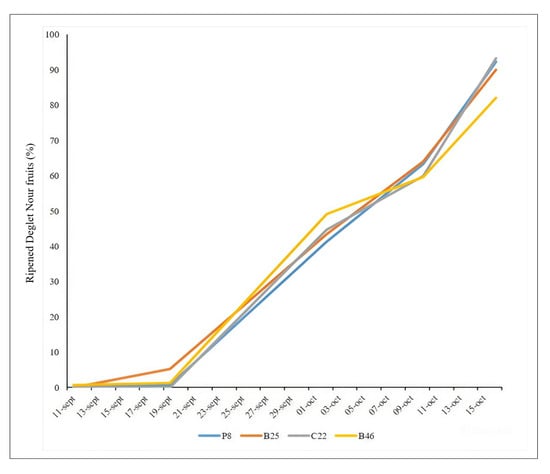
Figure 4.
Temporal evolution of the proportion of ripened Deglet Nour fruits pollinated by the four male cultivars.
These findings suggest that the timing of fruit ripening is strongly influenced by pollen sources, which has notable implications for fruit quality. Fruit from B25, which began maturing earliest on 19 September, exhibited pronounced biochemical changes, particularly in terms of water content and sugar concentration. These patterns may indicate a faster ripening process or an early metabolic adaptation. Early maturation can affect important characteristics such as fruit texture, sweetness, and postharvest handling.
The later maturation of fruits pollinated by C22 and P8 suggests a longer developmental phase, which may enhance fruit quality by enabling a more complete biochemical transformation. Extended maturation has been associated with improved sugar accumulation, better texture, and higher consumer acceptance in date fruits [21,28]. The relatively slower maturation of fruits pollinated by B46 suggests a distinct metabolic response, likely linked to genetic differences in pollen viability and its influence on fruit physiology.
These observations reinforce previous findings that the source of pollen has a direct impact on the physicochemical and biochemical properties of dates, as well as their ripening period. Omar [32] demonstrated that different male pollinators can significantly affect fruit size, sugar accumulation, and moisture levels, thereby influencing both the maturation timeline and overall fruit quality.
2.6. Effect of Pollination on Gene Expression of Cell Division Control Genes
Gene expression analysis of date palm fruits pollinated by different male cultivars revealed significant cultivar-dependent variability. Under our experimental conditions and compared to the control group (non-pollinated fruits), genes PdCD_1, PdCD_2 and PdCD_3, which encode cell division control proteins (PDK_XM_008786146.4, PDK_XM_008787172.4, and PDK_XM_039126641.1), were markedly upregulated, while the gene PdCD_4, PDK_XR_604216.4, showed significant downregulation (Figure 5).
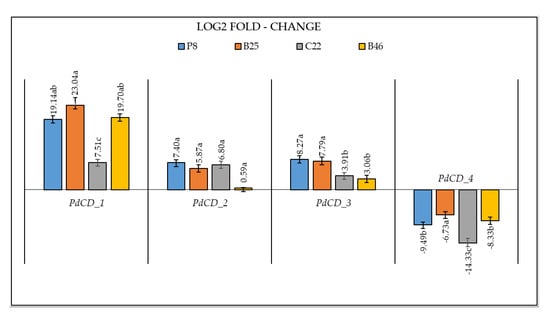
Figure 5.
Log2-fold change values determined by qPCR for 4 markers identified. PdCD_1: PDK_XM_008786146.4, PdCD_2: PDK_XM_008787172.4, PdCD_3: PDK_XM_039126641.1, and PdCD_4: PDK_XR_604216.4. Error bars represent the standard error of the mean. Different letters indicate statistically significant differences between gene expression levels (p < 0.05).
Among the analyzed genes, PdCD_1 was found to be the most prominently expressed transcript. Interestingly, fruits pollinated by cultivar C22 exhibited the lowest expression levels of this gene despite demonstrating superior biometric traits, such as increased fruit weight, length, and flesh thickness at the Bleh stage. Conversely, higher expression levels of PdCD_1 were observed in fruits fertilized by P8, B25, and B46. These results imply that the tested genes play different roles in fruit development. Specifically, the upregulation of PdCD_1 in fruits pollinated by P8, B25, and B46 likely reflects its involvement in promoting cell division and contributing to fruit growth. On the other hand, the notable size of C22-fertilized fruits, despite lower gene expression, may be attributed to cell expansion rather than division. This mechanism is often associated with nutrient accumulation and is considered a physiological compensation response to suboptimal fertilization, as reported by Ferri et al. [23]. To validate and strengthen the cell expansion hypothesis, additional experiments are required, including measurements of cell size and analysis of the expression of expansion-associated genes. Such investigations would provide direct evidence to distinguish between cell expansion and cell division as the primary contributors to the observed phenotypic variations. Integrating microscopic analyses with molecular profiling would provide a more precise understanding of the underlying developmental processes.
Similarly, PdCD_2 and PdCD_3 were expressed at lower overall levels; however, their expression remained elevated in fruits resulting from pollination with P8 and B25. This finding reinforces the hypothesis that these pollinators stimulate pathways associated with active growth and development. These results are consistent with the findings of Elmeer et al. [33], who emphasized that the genetic variability among male date palm cultivars significantly influences fruit set, quality, and gene regulation. It seems that the genotype of the pollinator not only determines fertilization success but also modulates the expression of key developmental genes, ultimately affecting cellular activity in the developing fruit.
The activation of genes related to cell division in response to specific pollen sources may be mediated by the hormonal contributions from both the pollen and the developing ovules. Auxins and gibberellins, which are synthesized in pollen grains and ovary tissues, are known to stimulate mitotic activity and promote tissue expansion in developing fruits [34,35]. These hormones can also trigger the endogenous production of additional auxins within ovarian cells, regulating both cell size and influencing the extent to which the fruit develops.
The consistently lower expression levels of genes associated with cell division in fruits pollinated by C22 suggest that this cultivar does not efficiently activate molecular pathways involved in cellular proliferation. By contrast, P8 and B25 appear to stimulate these pathways more effectively, as demonstrated by the increased expression of genes involved in regulating the cell cycle. Overall, these results highlight the critical role of male cultivar selection on the molecular and physiological processes of fruit development in date palms. A deeper understanding of the interaction between pollinator genotypes, hormone signalling, and gene expression could provide valuable insights into improving yield and fruit quality through targeted pollination practices.
3. Materials and Methods
3.1. Male Cultivar and Chlorotypes Analysis
In this study, four cultivars (P8, B25, C22, and B46) were selected from a group of 37 male date palm cultivars originating from a conservation plot at the Institute of Arid Regions (IRA) in Kébili, Tunisia. This plot conserves endangered cultivars and serves as a representative site for the genetic diversity of Tunisian date palms. All selected cultivars, except B25, were previously studied in our earlier research [9], in which their whole genomes were sequenced (BioProject ID: PRJNA951931). Selection was based on chlorotype differentiation. For B25, chloroplast sequence analysis was performed using the same protocol, and the resulting sequence was deposited in GenBank (Accession Number: BankIt2962577 B25/1_158462 PV882386). Genetic relatedness between chlorotypes was estimated using FastTree v2.1.8 with default parameters [16] and sequences were compared against the NCBI reference sequence GU811709.2.
3.2. Pollen Quality Assessment
Pollen from each date palm cultivar was collected from fully developed male inflorescences at the anthesis stage during both waves of the flowering period. The collected pollen was air-dried at room temperature for 48 h and then stored in airtight containers at 4 °C until further analysis. In vitro germination was carried out in Petri dishes containing a medium composed of 15% sucrose, 500 mg L−1 boric acid (H3BO3), 300 mg L−1 calcium nitrate (Ca(NO3)2), 200 mg L−1 magnesium sulfate (MgSO4), 100 mg L−1 potassium nitrate (KNO3), and 2.66 g L−1 of agar, all dissolved in distilled water. Pollen grains were incubated at 27 °C for six hours and examined under a light microscope. Germination was assessed based on the development of a pollen tube at least equal in length to the pollen grain diameter. Germination percentage was recorded hourly to evaluate germination power, and the maximum pollen tube length (µm) was measured at the end of the incubation period.
3.3. Pollination and Pollination Efficiency
Pollination was conducted during the first week of April 2024 on 25-year-old female date palms of the Deglet Nour cultivar, maintained under standardized and uniform cultivation practices, including fertilization and irrigation. Female spathes from the principal flowering wave (Wave 2) were selected and covered with Kraft bags to avoid cross contamination from external pollen sources. Pollination was performed by spraying a fresh pollen suspension (1 g in 1 L of deionized water) over the entire female spathe using a handheld sprayer. This aqueous pollen application technique was selected following three years of optimization in our laboratory, during which the effects of water salinity and the duration of pollen immersion were systematically evaluated. Our experimental trials demonstrated that pollen performance in date palm is highly sensitive to both salinity and immersion duration. A salinity gradient from 0 to 5 g/L revealed that even minimal salinity adversely affects pollen viability, with optimal germination consistently observed at 0 g/L. Moreover, immersion durations longer than two hours led to a significant decline in germination rates, underscoring the importance of minimizing exposure time during pre-pollination preparation. Based on these findings (unpublished data), the use of a fresh, zero-salinity solution was identified as the most effective approach, ensuring successful pollination and yielding the highest fruit set rates compared to traditional methods or dry pollen dusting. Pollen from each selected male cultivar was used to pollinate fourteen spathes belonging to 8 female trees. Additionally, eight spathes were maintained as negative control (without pollination). The percentage of fruit set, both in pollinated and unpollinated spathes, was recorded at the Kimri stage (the initial stage of date palm fruit development).
3.4. Morphological and Phytochemical Characterization
At the Bleh stage (Kimri, or green stage), data were collected on fruit traits. We evaluated the average weight, width, and length of both fruits and their seeds, as well as the average flesh thickness and ripening duration. Biochemical analysis was conducted on the Bleh stage to assess moisture, total sugar, and polyphenol contents. Moisture content was determined by freeze-drying the samples, with the percentage calculated based on the weight difference before and after desiccation. Total sugar and phenol contents were measured in the aqueous extracts. Total soluble sugars were determined using the anthrone method. Meanwhile, the Folin–Ciocalteu method was used to assess the total polyphenol content, with gallic acid serving as the reference standard.
3.5. RNA Extraction and cDNA Synthesis
Fruits at the Bleh stage, produced through pollination by various male cultivars, were ground into a fine powder in a pre-chilled mortar with liquid nitrogen. The MagicPure Total RNA Kit (TransGen Biotech Co., Ltd., Beijing, China) was used for RNA extraction from date fruit at the stage of Bleh. cDNA was synthetized using the SOLIScript® KIT following these conditions: 70 °C/5 min, 25 °C/5 min, 40 °C/30 min, and 83 °C/5 min. Complementary DNA was used for qPCR in an MJ Mini real-time PCR detection system (BioRad, Hercules, CA, USA).
3.6. Selection of Reference Genes and Primers Design
Based on the literature review, 21 genes that regulate cell division were initially selected (Figure S1), and their corresponding date palm gene sequences were retrieved from the reference genome available in the public NCBI database (https://www.ncbi.nlm.nih.gov/, accessed on 16 July 2025). Based on sequence homology, only four candidate genes were selected (Figure S1). Primers for cDNA amplification of these selected sequences were designed using the NCBI Primer-BLAST tool (Table S1).
3.7. qPCR and Relative Quantification of the Gene Expression
The qPCR reaction mixture consisted of 4 μL of Fast SYBR™ Green Master Mix, 1.2 μL each of forward and reverse primer, 5 μL of cDNA, and 8.6 μL of nuclease-free water. The thermal cycling conditions included an initial denaturation at 95 °C for 12 min, followed by 40 amplification cycles of 95 °C for 15 s, 60 °C for 30 s, and 75 °C for 30 s. Gene expression fold changes were determined using the 2−ΔΔCt method. Ct values for the target genes were normalized to Actin as the housekeeping gene [36] and compared to the control group (not pollinated fruits) for calibration. Each experiment was conducted with three biological replicates.
4. Conclusions
The study highlights the critical influence of pollen source on fertilization efficiency, fruit quality, and gene expression in date palms. The observed variations underscore the importance of selecting male cultivars based on pollen viability and metaxenic effects to optimize fruit production. Pollen from cultivars P8 and B25 exhibited the highest germination rates and tube elongation, enhancing fertilization success, whereas B46 showed moderate performance, and C22 demonstrated the lowest germination rate and tube growth, indicating limited pollination efficiency. Morphological and biochemical differences in the resulting fruits, including water retention, sugar accumulation, and polyphenol content, suggest that both genetic background of the pollinizer and its pollination efficiency significantly influence fruit quality. Early maturing fruits from B25 may offer commercial advantages in markets favoring early-season harvests, whereas late-maturing cultivars like P8 may yield higher-quality fruits with superior sensory and storage properties. Moreover, pollen source influenced the expression of key developmental genes, particularly those involved in cell division, thereby affecting fruit size, weight, and mesocarp thickness. Understanding these regulatory mechanisms provides valuable insights for refining breeding strategies and improve date palm productivity. Future research integrating molecular, physiological, and hormonal analyses, such as assessments of pollen viability, enzymatic activity, and hormone-mediated regulation of pollen tube growth, will further elucidate the mechanisms underlying effective pollination. The variability in ripening stages further emphasizes the importance of pollen selection for achieving targeted fruit development outcomes, enhancing both agronomic performance and commercial value. Overall, these findings provide practical guidance for breeding programs and orchard management, ultimately improving date palm cultivation through strategic pollination practices.
Supplementary Materials
The following supporting information can be downloaded at: https://www.mdpi.com/article/10.3390/horticulturae11070865/s1, Figure S1: NCBI PREDICTED Phoenix dactylifera cell division control protein; Table S1: Primers of the selected genes of the cell division control proteins.
Author Contributions
H.H.: Conceptualization, investigation, methodology, formal analysis, validation, and writing—original draft; M.A.B. and A.B.: methodology, validation; F.S.: software, formal analysis, review, validation; F.H.: investigation, validation; M.R.: validation, funding acquisition, conceptualization, project administration. All authors have read and agreed to the published version of the manuscript.
Funding
This work was supported and funded by the Deanship of Scientific Research at Imam Mohammad Ibn Saud Islamic University (IMSIU) (grant number IMSIU-DDRSP2502).
Data Availability Statement
The original contributions presented in this study are included in the article/Supplementary Material. Further inquiries can be directed to the corresponding author.
Conflicts of Interest
The authors declare no conflicts of interest.
Abbreviations
| cpDNA | Chloroplast DNA |
| qPCR | Quantitative PCR |
| SNP | Single-nucleotide polymorphism |
References
- Sedra, M.H.; Lashermes, P.; Trouslot, P.; Combes, M.; Hamon, S. Identification and genetic diversity analysis of date palm (Phoenix dactylifera L.) varieties from Morocco using RAPD markers. Euphytica 1998, 103, 75–82. [Google Scholar] [CrossRef]
- Hachef, A.; Bourguiba, H.; Cherif, E.; Ivorra, S.; Terral, J.-F.; Zehdi-Azouzi, S. Agro-morphological traits assessment of Tunisian male date palms (Phœnix dactylifera L.) for preservation and sustainable utilization of local germplasm. Saudi J. Biol. Sci. 2023, 30, 103574. [Google Scholar] [CrossRef]
- Elmeer, K.; Mattat, I. Marker-assisted sex differentiation in date palm using simple sequence repeats. 3 Biotech 2012, 2, 241–247. [Google Scholar] [CrossRef][Green Version]
- Abdelouahhab, Z.; Arias-Jimenez, E.J. Date palm cultivation, Food and Agriculture Organization of the United Nations (FAO) Agricultural Services. Bulletin 2002, 156. [Google Scholar]
- Djerbi, M. Disease of the Date Palm (Phoenix dactylifera L.). F.A.O Regional Project for Palm and Dates Research Center in the Near East and North Africa; FAO: Baghdad, Iraq, 1983; p. 127. [Google Scholar]
- Shafique, M.; Khan, A.S.; Malik, A.U.; Shahid, M.; Rajwana, I.A.; Saleem, V.A.; Ahmad, I. Influence of pollen source and pollination frequency on fruit drop, yield and quality of date palm (Phoenix dactylifera L.) cv. Dhakki. Pak. J. Bot. 2011, 43, 831–839. [Google Scholar]
- Pintaud, J.-C.; Ludena, B.; Zehdi, S.; Gros-Balthazard, M.; Ivorra, S.; Terral, J.-F.; Newton, C.; Tengberg, M.; Santoni, S.; Boughedoura, N. Biogeography of the date palm (Phoenix dactylifera L., Arecaceae): Insights on the origin and on the structure of modern diversity. ISHS Acta Hortic. 2013, 994, 19–38. [Google Scholar] [CrossRef]
- Hazzouri, K.M.; Gros-Balthazard, M.; Flowers, J.M.; Copetti, D.; Lemansour, A.; Lebrun, M.; Purugganan, M.D. Ge-Nome-Wide Association Mapping of Date Palm Fruit Traits. Nat. Commun. 2020, 11, 2464. [Google Scholar]
- Hamza, H.; Villa, S.; Torre, S.; Marchesini, A.; Benabderrahim, M.A.; Rejili, M.; Sebastiani, F. Whole mitochondrial and chloroplast genome sequencing of Tunisian date palm cultivars: Diversity and evolutionary relationships. BMC Genom. 2023, 24, 772. [Google Scholar] [CrossRef]
- Munier, P. Le Palmier-Dattier; GP Maisonneuve et Larose: Paris, France, 1973. [Google Scholar]
- Salomon-Torres, R.; Ortiz-Uribe, N.; Villa-Angulo, R.; Villa-Angulo, C.; Norzagaray-Plasencia, S.; García-Verdugo, C.D. Effect of pollenizers on production and fruit characteristics of date palm (Phoenix dactylifera L.) cultivar Medjool in Mexico. Turk. J. Agric. For. 2017, 41, 338–347. [Google Scholar] [CrossRef]
- Kadri, K.; Jemni, M.; Mesnoua, M.; Sharma, S.S.; Malik, A.A.; Makhlouf, S.; Elsafy, M. Study on the effects of pollen sources on the agronomic, biochemical, mineral, and pomological traits of date palm (Phoenix dactylifera L.) cv ‘Deglet Nour’ fruits in Degache Oases (Tunisia). Genet. Resour. Crop. Evol. 2024, 71, 3721–3733. [Google Scholar] [CrossRef]
- El-Kassaby, Y.A.; Klápště, J.; Guy, R.D. Breeding without Breeding: Selection Using the Genomic Best Linear Unbiased Predictor Method (GBLUP). New For. 2012, 43, 631–637. [Google Scholar] [CrossRef]
- Gros-Balthazard, M.; Galimberti, M.; Kousathanas, A.; Newton, C.; Ivorra, S.; Paradis, L.; Vigouroux, Y.; Carter, R.; Tengberg, M.; Battesti, V.; et al. The Discovery of Wild Date Palms in Oman Reveals a Complex Domestication History Involving Centers in the Middle East and Africa. Curr. Biol. 2017, 27, 2211–2218. [Google Scholar] [CrossRef] [PubMed]
- Hazzouri, K.M.; Flowers, J.M.; Nelson, D.; Lemansour, A.; Masmoudi, K.; Amiri, K.M.A. Prospects for the Study and Improvement of Abiotic Stress Tolerance in Date Palms in the Post-Genomics Era. Front. Plant Sci. 2020, 11, 293. [Google Scholar] [CrossRef] [PubMed]
- Price, M.; Dehal, P.S.; Arkin, A.P. FastTree 2–Approximately Maximum-Likelihood Trees for Large Alignments. PLoS ONE 2010, 5, e9490. [Google Scholar] [CrossRef] [PubMed]
- Yang, M.; Zhang, X.; Liu, G.; Yin, Y.; Chen, K.; Yun, Q.; Zhao, D.; Al-Mssallem, I.S.; Yu, J. The complete chloroplast genome sequence of date palm (Phoenix dactylifera L.). PLoS ONE 2010, 5, e12762. [Google Scholar] [CrossRef]
- Al-Khalifah, N.S.; Askari, E. Morphological and Molecular Characterization of Date Palm (Phoenix dactylifera L.) Cultivars in Saudi Arabia. J. Hortic. Sci. Biotechnol. 2003, 78, 392–398. [Google Scholar]
- Fu, Y. The actin cytoskeleton and signaling network during pollen tube tip growth. J. Integr. Plant Biol. 2010, 52, 131–137. [Google Scholar] [CrossRef]
- Adhikari, P.B.; Liu, X.; Kasahara, R.D. Mechanics of Pollen Tube Elongation: A Perspective. Front. Plant Sci. 2020, 11, 589712. [Google Scholar] [CrossRef]
- Chao, C.C.T.; Krueger, R.R. The date palm (Phoenix dactylifera L.): Overview of biology, uses, and cultivation. HortScience 2007, 42, 1077–1082. [Google Scholar] [CrossRef]
- Ouonkap, S.V.Y.; Palaniappan, M.; Pryze, K.; Jong, E.; Ali, M.F.; Styler, B.; Almasaud, R.A.; Harkey, A.F.; Reid, R.W.; Loraine, A.E.; et al. Enhanced pollen tube performance at high temperature contributes to thermotolerant fruit and seed production in tomato. Curr. Biol. 2024, 34, 5319–5333. [Google Scholar] [CrossRef]
- Ferri, A.; Giordani, E.; Padula, G.; Bellini, E. Viability and in vitro germinability of pollen grains of olive cultivars and advanced selections obtained in Italy. Adv. Hort. Sci. 2008, 22, 116–122. [Google Scholar]
- Zargari, M.; Sadeghi, M.; Aghdaie, F. Effect of pollen source on fruit set, yield, and quality of date palm (Phoenix dactylifera L.). Hort. Sci. Technol. 2021, 39, 512–523. [Google Scholar]
- Barreveld, W.H. Date Palm Products. In FAO Bulletin Services Agricole No 101; Food and Agriculture Organization of the United Nations: Rome, Italy, 1993. [Google Scholar]
- Sawaya, W.N.; Khalil, J.K.; Safi, W.J. Chemical Composition and Nutritional Quality of Date Seeds. J. Food Sci. 1984, 49, 617–619. [Google Scholar] [CrossRef]
- Al-Shahib, W.; Marshall, R.J. The fruit of the date palm: Its possible use as the best food for the future? Int. J. Food Sci. Nutr. 2003, 54, 247–259. [Google Scholar] [CrossRef] [PubMed]
- Yahia, E.; Woolf, A. Avocado (Persea americana Mill.). In Postharvest Biology and Technology of Tropical and Subtropical Fruits; Elsevier: Amsterdam, The Netherlands, 2011; pp. 125–186. [Google Scholar]
- Rygg, G.L. Date development, handling and packing in the United States. In Agricultural Handbook No. 482, 1st ed.; Agricultural Research Service, US Department of Agriculture Date Development: Washington, DC, USA, 1975. [Google Scholar]
- Hammouda, H.d.; Chérif, J.K.; Trabelsi-Ayadi, M.; Baron, A.; Guyot, S. Detailed polyphenol and tannin composition and its variability in Tunisian dates (Phoenix dactylifera L.) at different maturity stages. J. Agric. Food Chem. 2013, 61, 3252–3263. [Google Scholar] [CrossRef] [PubMed]
- Al-Turki, S.; Shahba, M.A.; Stushnoff, C. Diversity of antioxidant properties and phenolic content of date palm (Phoenix dactylifera L.) fruits as affected by cultivar and location. J. Food Agric. Environ. 2010, 8, 253–260. [Google Scholar]
- Omar, A. Effect of amount of pollen on anatomy and quality of Zagloul date palm fruit (Phoenix dactylifera, L.). In ARAB PALM Conference, Proceedings of the First International Scientific Conference for the Development of Date Palm and Dates Sector in the Arab World, Riyadh, Saudi Arabia, 4–7 December 2011; National Centre for Agriculture Technologies: Riyadh, Saudi Arabia, 2011; Volume 1, pp. 121–131. [Google Scholar]
- Elmeer, K.; Mattat, I. Genetic diversity of Qatari date palm using SSR markers. Genet. Mol. Res. 2015, 14, 1624–1635. [Google Scholar] [CrossRef]
- Liu, M.; Pirrello, J.; Chervin, C.; Roustan, J.-P.; Bouzayen, M. Ethylene control of fruit ripening: Revisiting the complex network of transcriptional regulation. Plant Physiol. 2015, 169, 2380–2390. [Google Scholar] [CrossRef]
- Ozga, J.A.; Reinecke, D.M. Hormonal interactions in fruit development. J. Plant Growth Regul. 2003, 22, 73–81. [Google Scholar] [CrossRef]
- Patankar, H.V.; Assaha, D.V.M.; Al-Yahyai, R.; Sunkar, R.; Yaish, M.W. Identification of Reference Genes for Quantitative Real-Time PCR in Date Palm (Phoenix dactylifera L.) Subjected to Drought and Salinity. PLoS ONE 2016, 11, e0166216. [Google Scholar] [CrossRef]
Disclaimer/Publisher’s Note: The statements, opinions and data contained in all publications are solely those of the individual author(s) and contributor(s) and not of MDPI and/or the editor(s). MDPI and/or the editor(s) disclaim responsibility for any injury to people or property resulting from any ideas, methods, instructions or products referred to in the content. |
© 2025 by the authors. Licensee MDPI, Basel, Switzerland. This article is an open access article distributed under the terms and conditions of the Creative Commons Attribution (CC BY) license (https://creativecommons.org/licenses/by/4.0/).
